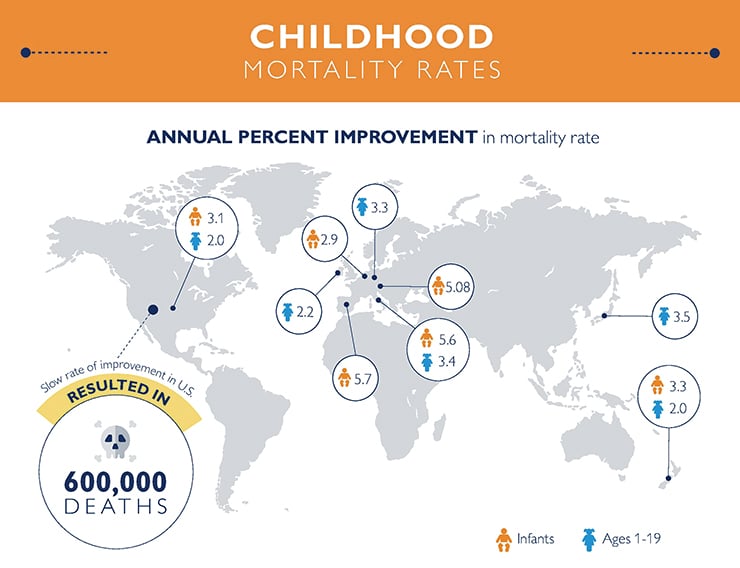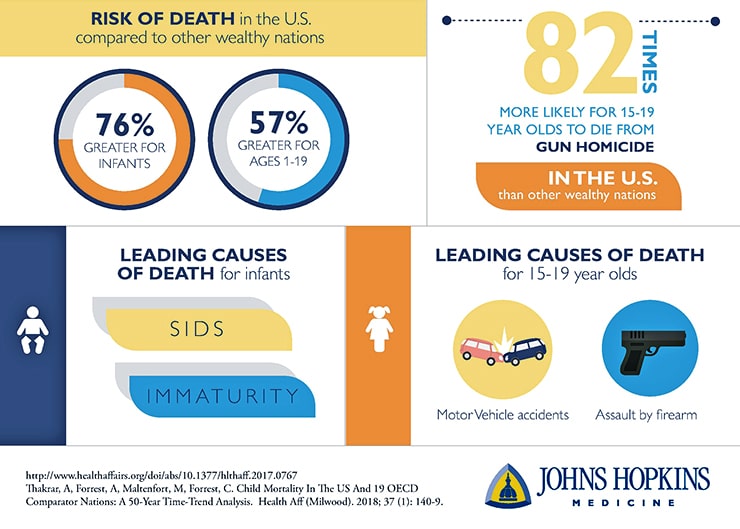The United States has been slowest among 20 economically similar nations to improve childhood mortality rates, according to new research.
“The findings show that in terms of protecting child health, we’re very far behind where we could be.”
While looking at deaths between 1961 and 2010, researchers found that US childhood mortality has been higher since the 1980s than those in all 19 peer nations. Further, over the 50-year study period, lagging improvement in the United States has led to more than 600,000 excess deaths.
“Overall, child mortality in wealthy countries, including the US, is improving, but the progress our country has made is considerably slower than progress elsewhere,” says Ashish Thakrar, an internal medicine resident at Johns Hopkins Hospital and lead author of the study, which appears in Health Affairs. “Now is not the time to defund the programs that support our children’s health.”

A report of the findings highlights when and why US performance started falling behind peer countries. The researchers call for continued funding of federal, state, and local programs that have proven to save children’s lives, including the Children’s Health Insurance Program and the Supplemental Nutrition Assistance Program, or food stamps.
Premature births and sudden infant death syndrome were among the leading causes of death for the most recent decade, the researchers say. Children in the United States were three times more likely to die from prematurity at birth and more than twice as likely to die from SIDS.
The two leading causes of death for those 15 to 19 years old in the United States during the same period were motor vehicle accidents and assaults by firearm. Teenagers were twice as likely to die from motor vehicle accidents and 82 times more likely to die from gun homicide in the United States than in the other wealthy nations.

While the United States spends more per capita on health care for children than other wealthy nations, it has poorer outcomes than many, Thakrar says. In 2013, the United Nations Children’s Fund ranked the United States 25th of 29 developed countries for overall child health and safety.
Reducing infant mortality trims lifespan inequality
To learn when and why the US performance in improving child death rates began faltering compared to peer nations, researchers tracked child mortality rates for 20 nations that are members of the Organization for Economic Cooperation and Development. The members include Canada, Australia, Switzerland, Italy, and Germany, among others, which have similar levels of economic development.
The researchers analyzed mortality and population data from the Human Mortality Database and mortality and cause of death data from the World Health Organization for all children up to 19 years old from 1961 to 2010.
Some 90 percent of these deaths occurred among infants and adolescents 15 to 19. In the most recent decade studied (2001-2010), infants in the United States were 76 percent more likely to die and children 1 to 19 years old were 57 percent more likely to die than counterparts in peer nations.
“The findings show that in terms of protecting child health, we’re very far behind where we could be,” says Christopher Forrest, the study’s senior author and a pediatrician at Children’s Hospital of Philadelphia. “We hope that policymakers can use these findings to make strategic public health decisions for all US children to ensure that we don’t fall further behind peer nations.”
Child deaths drop by 48% globally since 1990
Collaborators are from Drexel University College of Medicine and Children’s Hospital of Philadelphia. Funding for the research came from the Children’s Hospital of Philadelphia.
Source: Johns Hopkins University



